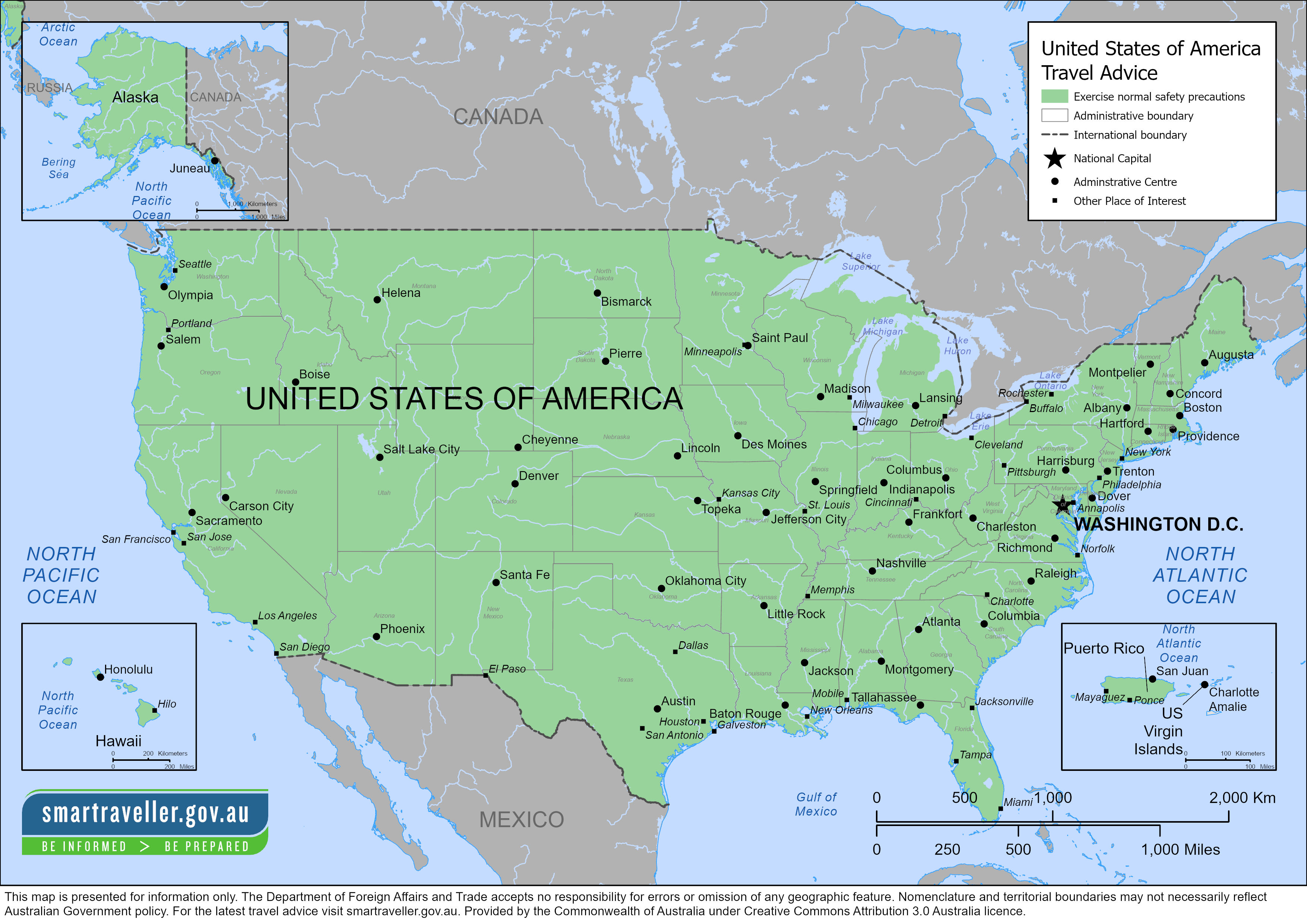The US has strict entry requirements for both tourists and transit passengers. US authorities won’t allow you to enter the country if you don’t comply.
If you’re visiting the US for less than 90 days, you may be eligible to:
- apply for an Electronic System for Travel Authorization (ESTA) and then
- enter under the Visa Waiver Program (VWP)
Otherwise, you’ll need to get a visa before you travel.
Visa and other entry and exit conditions can change at short notice, including currency, customs and quarantine rules. Contact an embassy or consulate of the United States for the latest details.
More information:
Visa-free travel for short stays
If you plan to visit the US for less than 90 days, you may be able to travel under the VWP. This includes travel to the US Virgin Islands and Puerto Rico.
You can’t enter the US under the VWP if you have:
- been denied an ESTA or entry under the VWP
- been denied a US visa
- an emergency passport, document of identity or Provisional Travel Document
- a criminal record
- been arrested but not convicted
- dual citizenship with Iran, Iraq, North Korea, Sudan or Syria
- travelled to Iran, Iraq, Libya, North Korea, Somalia, Sudan, Syria or Yemen since 1 March 2011, with limited exceptions
Other conditions apply.
Before travelling under the VWP, you must apply and be pre-approved via the ESTA.
US authorities recommend that you apply as soon as you know you’ll be travelling. ESTA approvals can take up to 72 hours.
ESTAs are valid for 2 years and for multiple entries.
You’ll need to apply for a new ESTA if:
- you renew your passport within the 2-year period
- your VWP eligibility changes
If there are differences between your ESTA, passport or ticket information, you could be:
- refused entry
- referred for secondary inspection (where an officer may interview you)
If your ESTA application is denied, you’ll need to apply for a visa from a US embassy or consulate.
US authorities generally won’t tell you why your ESTA application was rejected, and you can’t appeal their decision.
If you provide false or incorrect information on an ESTA, you may be permanently barred from travel to the US.
Ensure that you are aware of all the terms and conditions of entering and re-entering the US under VWP before attempting to enter the US on your ESTA.
More information:
Visas
If your ESTA application is denied or you’re not eligible to travel under the VWP, or you intend to stay for more than 90 days, you’ll need to apply for a visa from a US embassy or consulate.
The category of visa you need to apply for will depend on your reason for travel.
More information:
Arrival and departure record (Form I-94)
When you arrive, US authorities will determine your admissibility and decide the date by which you must leave the country. This date may not be the same as the expiry date of your ESTA or visitor visa.
A US Customs and Border Protection (CBP) official should:
- stamp your passport and write the date you must leave on the stamp
- issue you with an electronic or paper Form I-94 (Arrival/Departure Record)
Your I-94 is evidence of your legal status in the US and shows the date by which you must leave the country.
You can check your I-94 with CBP each time you enter the US.
If you stay past your I-94 expiry date, you can be detained, deported and barred from re-entering the US.
If you need to extend your stay in the US, lodge a request with US Citizenship and Immigration Services (USCIS) on Form I-539 before your I-94 expires.
You can’t extend or renew your I-94 by travelling to Canada, Mexico or the Caribbean for 30 days or less and then re-entering the US.
If you travel to Canada, Mexico or the Caribbean and return to the US while your I-94 is still valid, you’ll be readmitted for the amount of time left on it.
If your I-94 has recently expired and US authorities think the purpose of your trip was only to extend your stay in the US, they can:
- refuse you entry
- detain and deport you
If you’re issued a paper I-94 when you arrive at a land border, give it to the airline, cruise line or CBP officials when you leave the US.
Entry into the US
Having an approved ESTA or valid visa doesn’t guarantee entry to the US. It allows you to board a US-bound plane or vessel.
US Customs and Border Protection (CBP) officials at the port of entry will decide if you can enter the country.
Entry requirements are strict. Authorities have broad powers when deciding if you’re eligible to enter and may determine that you are inadmissible for any reason under US law.
At the port of entry, be prepared to answer questions about:
- the purpose of your visit
- how long you plan to stay
- where you will stay
- your ties to Australia
Officials may ask to inspect your electronic devices, emails, text messages or social media accounts.
Whether you enter the US under the VWP or on a visa, it’s likely you’ll need to have:
- an onward or return ticket that doesn’t terminate in Canada, Mexico or the Caribbean unless you’re a resident of one of those countries
- proof you have enough money to support yourself during your stay
If you provide false information or can’t satisfy the officials that you’re visiting for a valid reason, you can be refused entry.
You may be held at the port of entry or a nearby detention facility while US authorities arrange for you to be returned to Australia (or the last country you visited).
If you’re refused entry under the VWP, you generally don’t have the right to an attorney or to appeal the decision.
COVID-19 measures
You don’t need to take a COVID-19 test before travelling to the US.
US authorities may still deny boarding of any US-bound traveller showing signs of illness. Expect enhanced screening procedures, including for domestic flights within the US.
Further information and advice is available from the Centers for Disease Control and Prevention (CDC) and the Transportation Security Administration (TSA).
Requirement to be fully vaccinated against COVID-19
All travellers aged 18 and over must be fully vaccinated against COVID-19 and provide proof of vaccination to travel to the US unless you’re a US citizen, US permanent resident, or you qualify for one of the very limited exceptions to this requirement.
Further information is available on the CDC website.
If you’re not fully vaccinated but qualify for an exception, you may be required to attest that:
- You’ll be tested with a COVID-19 viral test 3 to 5 days after arrival in the US unless you have documentation of having recovered from COVID-19 in the past 90 days;
- You’ll self-quarantine for a full 7 days, even if the test result of the post-arrival viral test is negative, unless you have documentation of having recovered from COVID-19 in the past 90 days; and
- You’ll self-isolate if the result of the post-arrival test is positive or if you develop COVID-19 symptoms.
If you’re not fully vaccinated and intend to stay in the US for longer than 60 days, you may also be required to attest that:
- You agree to be vaccinated against COVID-19; and
- You have arranged to become fully vaccinated against COVID-19 within 60 days of arriving in the US or as soon thereafter as is medically appropriate.
If you’re fully vaccinated, make sure your vaccine and proof of vaccination are accepted in the US.
Children under the age of 18 are excepted from the vaccination requirement.
Additional requirements
Some US states have their own requirements for new arrivals from overseas and/or other US states.
Further information can be found on the websites of the individual states.
For further information regarding requirements before and during travel to the US and following your arrival, visit the CDC website.






More Stories
Canadian government issues Travel Advisory for thriteen Mexican states
Canada Issued Travel Advisories For These 7 Tourist Hot Spots & It Could Affect Your Trip
Mexico-bound snowbirds face stern travel warning from government